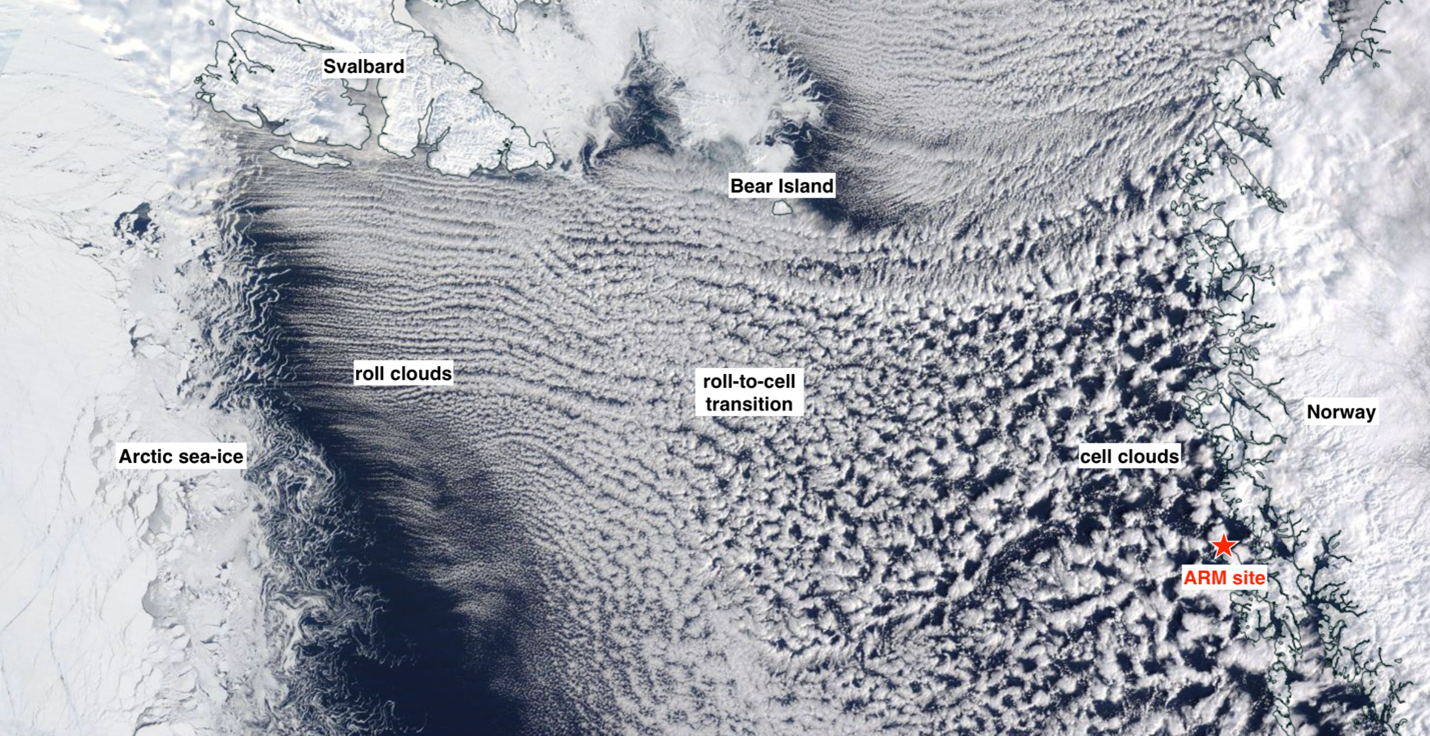Understanding how clouds evolve during arctic cold-air outbreaks
Submitter
Fast, Jerome D
— Pacific Northwest National Laboratory
Area of Research
Cloud Processes
Journal Reference
Wu P and M Ovchinnikov 2022. "Cloud morphology evolution in Arctic cold‐air outbreak: two cases during COMBLE period." Journal of Geophysical Research: Atmospheres, 127(10), e2021JD035966, 10.1029/2021JD035966.
Science

Figure 1. Cloud pattern changes when the airmass travels from near the sea-ice to Norway. (Image by National Aeronautics and Space Administration Worldview.)
Observations show that cloud patterns transform from elongated rolls to broken cells along the pathway of a cold-air outbreak (CAO). However, the internal cloud processes that cause these changes are poorly understood. Researchers selected two cases of cloud pattern transitions seen during the Atmospheric Radiation Measurement (ARM) Cold-air Outbreak in Marine Boundary Layer Experiment (COMBLE) campaign to characterize the evolution of cloud morphology (e.g., size, horizontal aspect ratio) along cold-air pathways and how the cloud shape transition correlates with different environmental properties. They used an object segmentation method to identify individual clouds from satellite images and obtained cloud morphology statistics. They then analyzed how cloud morphology changes with the environment, with a focus on the region where roll clouds break up. The methodologies are being used in ongoing research to quantify cloud morphology in numerical simulations and examine how the roll-to-cell transition is modulated by surface fluxes and cloud microphysics.
Impact
Marine CAO events over the Arctic play an important role in the region’s climate. While clouds are ubiquitous during marine CAOs, they are poorly represented in weather and climate models. Simulating CAO clouds is difficult due to their small size relative to the model grid. This size difference makes it hard to resolve the processes happening in the clouds. This study characterizes how cloud sizes evolve with the changing environment along the fetch of CAOs. The quantitative results are critical for evaluating and improving cloud morphology simulations in next-generation models.
Summary
Cloud morphology, including cloud size and spatial distribution, is a key factor that directly affects how clouds can absorb and emit radiation. In this work, researchers used two cases observed during the COMBLE field campaign to study the evolution of cloud size distributions as an air mass moves from the Arctic over a comparatively warm ocean and characterize cloud mesoscale organization as it changes from rolls to cells. They identified clouds from satellite images and found the roll-to-cell transition region from the homogeneity of the cloud water paths.
A local minimum in wind shear, a local maximum in cloud size, and a local maximum in marine cold-air outbreak index accompany the roll-to-cell transition. Cloud horizontal aspect ratios (length divided by width) have weak fetch dependency, and the mean values are almost the same in roll, transition, and cell regimes. That means clouds tend to have the same shape along the cold-air pathway, whether they are big or small. Most clouds have small sizes (e.g., < 10 km2), regardless of where the cold air is in its pathway, while few large clouds (e.g., > 100 km2) contribute most of the cloud cover in the transition and cell regimes (our eyes usually capture those large clouds rather than the numerous small clouds). After roll clouds break up, cloud size distributions show bimodality with an additional peak at ~100 km2, compared to the single peak at ~1 km2 before breakup. The presented statistical results pave the way for evaluating model-simulated cloud organizations during CAO events.
Keep up with the Atmospheric Observer
Updates on ARM news, events, and opportunities delivered to your inbox
ARM User Profile
ARM welcomes users from all institutions and nations. A free ARM user account is needed to access ARM data.


















